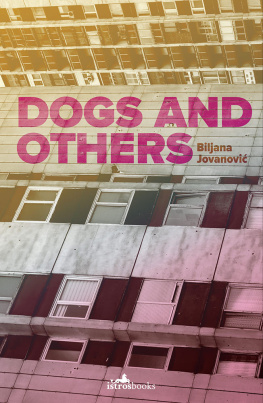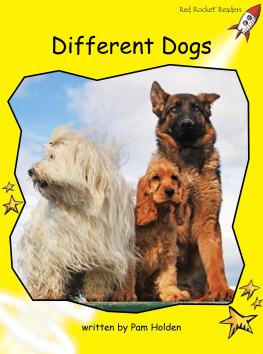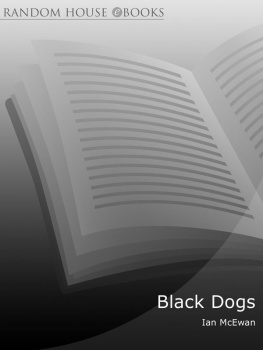Jovanović - Dogs and Others
Here you can read online Jovanović - Dogs and Others full text of the book (entire story) in english for free. Download pdf and epub, get meaning, cover and reviews about this ebook. year: 2018, publisher: Istros Books, genre: Art. Description of the work, (preface) as well as reviews are available. Best literature library LitArk.com created for fans of good reading and offers a wide selection of genres:
Romance novel
Science fiction
Adventure
Detective
Science
History
Home and family
Prose
Art
Politics
Computer
Non-fiction
Religion
Business
Children
Humor
Choose a favorite category and find really read worthwhile books. Enjoy immersion in the world of imagination, feel the emotions of the characters or learn something new for yourself, make an fascinating discovery.
Dogs and Others: summary, description and annotation
We offer to read an annotation, description, summary or preface (depends on what the author of the book "Dogs and Others" wrote himself). If you haven't found the necessary information about the book — write in the comments, we will try to find it.
Dogs and Others — read online for free the complete book (whole text) full work
Below is the text of the book, divided by pages. System saving the place of the last page read, allows you to conveniently read the book "Dogs and Others" online for free, without having to search again every time where you left off. Put a bookmark, and you can go to the page where you finished reading at any time.
Font size:
Interval:
Bookmark:

Table of Contents
BILJANA JOVANOVI
DOGS AND OTHERS
Translated by John K. Cox
First published in 2018 by Istros Books
London, United Kingdom www.istrosbooks.com
Copyright Estate of Biljana Jovanovi, 2018
This book was first printed in Serbia, Psi i ostali (Belgrade: Prosveta, 1980).
The right of Biljana Jovanovi, to be identified as the author of this work has been asserted in accordance with the Copyright, Designs and Patents Act, 1988
Translation John K. Cox , 2018
Cover design and typesetting: Davor Pukljak, www.frontispis.hr
ISBN
Print: 978-1-912545-16-2
MOBI: 978-1-912545-17-9
ePub: 978-1-912545-18-6
The publisher wishes to acknowledge the support of the Serbian Ministry of Culture & Media in the publication of this book.
Translators Preface
Most names and other proper nouns in this translation have been left in their original Serbo-Croatian (as Jovanovic would have said) forms. An exception was made for the most common version of the narrators first name, Lidija, which we have rendered as Lidia for the sake of readability.
The text used as the basis for this translation was Biljana Jovanovics Psi i ostali (Belgrade: Prosveta, 1980).
Understanding This Book
Certain generalizations about plot or style, or specific notes on scenes, hard-won by another reader, can make a complex, or intricate, novel such as this one easier to understand. For instance, without a character list for the whole work, it might be helpful to untangle all the characters whose names begin with the letter M:
Marina the mother of Lidia and Danilo, who is mostly absent and often cruel
Marko Danilos dodgy friend
Mihailo the father of Lidia and Danilo, who hanged himself a decade or so ago
Milena Lidias lover, a friend of Danilo and eda Little River
Mira Danilos girlfriend
In terms of style, readers should be aware that Lidias narration contains many meta-references (e.g., questions about things she just said) and experienced details in the tradition of the French nouveau roman; there are also neologisms (sometimes adjectives, as in crumby, as opposed to crummy; but often adverbs, as in postmanly and bankerly-cordially) and, in recorded speech, drawled or drawn-out words spelled with urgently repeated vowels.
Subject matter such as bodily fluids (snot, semen, rheum, secretions connected to sexually-transmitted diseases), raw sexuality, and characters pinioned uncomfortably in the citys infernal machine might qualify the text as a kind of dirty realism, but its political content is equally obvious. The settling of accounts of a traditional-minded man (is it a man?) with. second-wave feminism in Chapter 25 is highly unsettling, but instructive.
There are many ways to read, or interpret, this novel. Literary critics have noted that it is here, in her second major work of prose, that Jovanovi found her voice. Indeed, her breakout success from two years earlier (1978), Pada Avala (Eng.: Avala is Falling) became a cult classic; and although it was, in the opinion of this translator, far too transgressive and energetic to deserve the label jeans prose, that is how it is often designated to this day. But Dogs and Others delivered a wholescale re-imagination of the role of the author and the narrator, and here Jovanovi took her art to a different level. (Her third novel, My Soul, My One and Only from 1984, and her unfinished fourth novel from the 1990s, move into different territory yet again.)
Literary scholars, of course, also sort out how this book is put together, how it functions, and why it works. One notices immediately the pell-mell energy of the digressive narration; the intertextuality (various letters, pamphlets, and flashbacks set off from the main text); the mystifying epigraphs; and the free and stubborn images dreams looking for vocabulary, images looking for form. And yet, the novel holds together. The red threads lead somewhere. The references come home to roost. Its not a farce, not an ironic romp, not an act of heedless satire or feckless cynicism.
Consideration or analysis of the content of the novel is also both demanding and valuable. Jovanovi herself noted that the novel was a debt, a debt to myself, to bring things that seemed important to me at the time out into the open, and to strip them completely naked. Is this novel the fruit of the evolution of the increasing tide of creditable woman-centred writing in Yugoslavia, distilled into rocket fuel by the addition of feminist sensibilities from the West? How important is the fact that this novel contains what appears to be the first detailed depiction of a sexual relationship between two women in Serbian literature?
Interesting historical explanations, stressing the socio-economic or even political context of the plot and the times in which the manuscript was produced and published, are also possible. Jovanovi was too young to be a direct part of the generation of 1968, but not too young to engage or interact (positively and negatively) with that movements causes and ideals. She was definitely too young to be considered one of the children of communism. Related phenomena such as membership in the red bourgeoisie or, as some of her critics might say, her generations position as beneficiaries of post-war social mobility who supposedly repaid the system with unruliness or anarchism also miss the mark, but they are in circulation. Also plausible are critiques of work like hers from the Marxist or neo-Marxist; the presence of the Praxis philosophers in Yugoslavia during her lifetime provides a lot of ready material for analysis. One could also take, ideologically or historically, a Titoist perspective, whereby Jovanovis novels can be seen to deviate from the established canon of socialist aestheticism or Partisan realism. One could also maintain, as does this observer, that Jovanovis attention to radically new subjects and her transgressive literary innovations amount to social criticism, which in turn represents a kind of urban extension, and logical continuation, of the anti-fascist moment of World War II.
John K. Cox , Fargo, USA. 2018
*
This translation is dedicated to William E. Bill Schmickle, the most brilliant teacher I ever had. No one ever lit up Founders Hall or Duke Memorial with ideas and lectures and writing the way he did, and no professor ever pushed me as hard or rewarded me as generously.
In Place of an Introduction
This story does not consist of night-and-day phantasmagorias, but of Dogs and Others. No joke: Others and Dogs. Since a position favouring the relativity of truth is psychologically more justifiable than one favouring the absoluteness of truth, and since its not out of the question that its also epistemologically more reliable, then its true and let us thank God for it its true, that which is written in books, in church and in other places: Dogs always believe that they belong to Others (whom they consider to be, for unknown reasons enduring right up to our day, better than they are). The Others are not always convinced that they are not themselves Dogs. Still, though, Dogs are Others and Others are Dogs. The one thing that actually distinguishes them from each other, now and again (and something that justifies singling them out for participation in this story), is the level of their (as numerous personages are wont to say, and learned ones at that) social adaptation.
What nonsense! Whats this sort of thing supposed to mean to Dogs? Or especially to Others?
Whatever both the one group and the other suffocate in the same typical stinking mess that is life:
I
For a longish, and rounded, amount of time (like a lie on Jaglikas lips), I took, with the certainty of an idiot, her stories and those of Marina to be images from my own childhood; and of course I believed unshakably in my ownership of those images. Im not sure when that all went up in smoke! All efforts up to this point have been inaudible (unsuccessful), like clacking ones dry, untrimmed fingernails together or timidly scratching the edge of a table with a pin; there was a huge tangle in my head and I felt it whenever I tried to remember something, or with inappropriate ambition tried to recall anything at all with complete accuracy; the bit that I could get my hands on was quickly lost amid the concentric braid of other pictures, and there was no way for me to find the beginning or the end. And then everything snapped, went off like a bomb; no; like a hundred and twenty glasses tossed from the tenth floor; and nothing remained; not even anything like the rubber stub thats left behind when a balloon pops or, you know, an inflated plastic bag explodes.
Font size:
Interval:
Bookmark:
Similar books «Dogs and Others»
Look at similar books to Dogs and Others. We have selected literature similar in name and meaning in the hope of providing readers with more options to find new, interesting, not yet read works.
Discussion, reviews of the book Dogs and Others and just readers' own opinions. Leave your comments, write what you think about the work, its meaning or the main characters. Specify what exactly you liked and what you didn't like, and why you think so.











